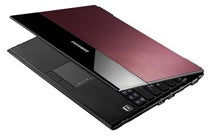 |
Samsung’s X360 (Reuters) |
SAN FRANCISCO — Diversified electronics maker Samsung Electronics said it is re-entering the U.S. computer market with a range of branded products that build on its component supply strengths.
The Korean-based company will introduce on Tuesday new ultralight notebooks designed to appeal to potential buyers of Apple’s (NASDAQ: AAPL) ground-breaking MacBook Air and smaller “netbook” models from the likes of Asustek Computer.
Breaking into the crowded U.S. market involves taking share from more established players. The Korean electronics maker sees other Asian brand-name players as vulnerable, especially Toshiba Corp, Sony Corp and Lenovo.
Samsung is also coming out with models aimed at business professionals and the market for bulkier laptops known as “desktop replacements,” a Samsung executive said.
Like Apple’s Air, Samsung’s X-Series premium lightweight notebooks come with options for either a hard drive or solid state memory. But Samsung’s X360 is priced at $2,499 and carries 128 gigabytes of flash memory, twice the 64 gigabytes that comes with the Apple Air selling for $2,598.
“These products really go after Apple and Sony. This is the MacBook Air killer,” Bret Berg, the senior product manager for Samsung’s U.S. computer division, said in an interview.
The X360 weighs 2.8 pounds and has an ultra-thin, tapered wedge design with a magnesium allow chassis, an aluminum top and a “pebble”-style keyboard.
Samsung’s hard-drive version, the X460, starts at $1,899 for a 160-gigabyte hard drive, twice the capacity of Apple’s existing MacBook Air model that is priced at $1,799 for an 80-gigabyte drive. The X460 weighs just under 4.2 pounds.
NETBOOK
Its premium netbook, the NC10, in white or metallic-blue colored cases, starts at $499 with a 10.2-inch display and 160 gigabyte hard drive. Netbooks are a smaller class of PCs that are lower priced than notebooks and can sell for $300 or less.
Samsung is positioning its product between lower cost EEE PCs from Asustek and the smallest full-scale notebooks. Samsung’s model bears a resemblance to an 11-inch notebook Sony sold earlier this decade that was popular with mobile business professionals but cost upward of $2,000 at that time.
One cost advantage is that many of the components inside Samsung machines are made by its semiconductor and other finished product businesses. This includes Samsung’s SuperBrite light-emitting diode, backlit liquid crystal displays.
It estimates that 80 percent of the value of its PCs are from Samsung components — everything but the microprocessor and graphics chips. As the world’s biggest maker of memory chips, storage is Samsung’s biggest weapon.
The reentry into the U.S. highly competitive computer market will also be aided by Samsung’s strong established ties with business resellers, distributors and consumer retailers through sales of everything from TVs to monitors to phones.
In the first quarter of 2009, Samsung plans to rev up its sales distribution strategy, including corporate distributors such as CDW or Newegg and consumer retailers such as Best Buy, and regional U.S. store chains Fry’s Electronics or The Wiz.
Samsung’s announcement, which has been in the works for more than a month, coincides with Apple’s announcement later on Tuesday of upgraded notebook models. Analysts predict Apple may introduce a new line of notebooks for under $1,000.


